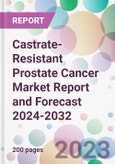The castrate resistant prostate cancer market was valued at USD 11.2 billion in 2023, driven by increasing collaboration among pharmaceutical companies. The market size is anticipated to grow at a CAGR of 8.7% during the forecast period of 2024-2032 to achieve a value of USD 23.5 billion by 2032.
Castrate Resistant Prostate Cancer: Introduction
Castration-resistant prostate cancer (CRPC) is a form of prostate cancer that no longer responds to medical or surgical interventions that lower testosterone levels in the body, such as surgical castration (removal of the testicles) or androgen deprivation therapy (ADT). Testosterone is a male hormone that can stimulate the growth of prostate cancer cells. When prostate cancer becomes resistant to these therapies, it can continue to grow and spread even in the absence of testosterone.Key Trends in the Global Castrate Resistant Prostate Cancer Market
The castrate resistant prostate cancer market has been experiencing significant growth and evolution in recent years. Several key trends are some key trends shaping the market:
- Emerging Therapies: New therapeutic options, including novel androgen receptor-targeted therapies, immunotherapies, and radiopharmaceuticals, are continuing to emerge. These treatments aim to provide improved efficacy and fewer side effects for CRPC patients.
- Biomarker-Driven Treatment: Personalized medicine approaches are gaining prominence. Biomarker testing helps identify specific genetic mutations or protein markers that guide treatment decisions, ensuring patients receive therapies tailored to their unique molecular profiles.
- Immunotherapy Advancements: Immune checkpoint inhibitors and other immunotherapies are being explored for their potential in treating CRPC. These therapies aim to harness the patient's immune system to target cancer cells.
- Radiopharmaceuticals: Radiopharmaceuticals such as radium-223 (Xofigo) have been approved for the treatment of CRPC patients with bone metastases. This trend continues to evolve with the development of new agents.
- Combination Therapies: Researchers and pharmaceutical companies are investigating combination therapies that target multiple pathways involved in CRPC simultaneously. This approach aims to enhance treatment efficacy and delay disease progression.
Castrate Resistant Prostate Cancer Market Segmentations
The market can be categorized into therapy type, therapy drug class, route of administration, distribution channel, and region.Market Breakup by Therapy Type
- Hormonal Therapy
- Immunotherapy
- Chemotherapy
- Others
Market Breakup by Therapy Drug Class
- Antineoplastic
- Non-steroidal Antiandrogen
- Corticosteroids
- Others
Market Breakup by Route of Administration
- Oral
- Parenteral
Market Breakup by Distribution Channel
- Hospital Pharmacy
- Retail Pharmacy
- Online Pharmacy
Market Breakup by Region -7MM
- United States
- EU-4 and the United Kingdom
- Japan
Castrate Resistant Prostate Cancer Market Overview
The market for Castrate Resistant Prostate Cancer (CRPC) continues to be a significant and evolving aspect of the oncology landscape. CRPC, a stage of prostate cancer that no longer responds to hormone therapy, has seen notable advancements in diagnosis and treatment. Innovative therapies, including next-generation anti-androgens and immunotherapies, have been approved and are offering new hope to patients with CRPC. Additionally, molecular profiling and precision medicine approaches are gaining prominence in tailoring treatments to individual patients, enhancing their efficacy, and reducing side effects. Clinical trials are ongoing, exploring novel therapeutic modalities, combination therapies, and biomarker-driven interventions. The CRPC market remains dynamic, with a focus on improving patient outcomes, enhancing the quality of life, and extending survival for those affected by this challenging form of cancer. Collaboration among pharmaceutical companies, research institutions, and healthcare providers plays a pivotal role in advancing CRPC treatment options.Key Players in the Castrate Resistant Prostate Cancer Market
The key features of the market report include patent analysis, grants analysis, clinical trials analysis, funding and investment analysis, partnerships, and collaborations analysis by the leading key players.The major companies in the castrate resistant prostate cancer market are as follows:
- Sanofi
- Johnson & Johnson Services Inc.
- Pfizer Inc.
- Astellas Pharma, Inc.
- Bayer AG
- F. Hoffmann-La Roche Ltd.
- Mylan N.V.
- Teva Pharmaceutical Industries Ltd.
- GlaxoSmithKline plc
- Novartis AG
- Eli Lilly and Company
- Merck & Co., Inc.
- Allergan
- AstraZeneca
- Cipla Inc.
- Amneal Pharmaceuticals LLC
Table of Contents
1 Preface
3 Castrate-Resistant Prostate Cancer Overview
4 Patient Profile
5 Castrate-Resistant Prostate Cancer Epidemiology Analysis-7MM
6 Castrate-Resistant Prostate Cancer Market Overview
7 Castrate-Resistant Prostate Cancer Market Landscape
8 Castrate-Resistant Prostate Cancer Challenges and Unmet Needs
10 Castrate-Resistant Prostate Cancer Market Dynamics
11 Castrate-Resistant Prostate Cancer Market Segmentation
12 United States Castrate-Resistant Prostate Cancer Market
13 EU-5 and the United Kingdom Castrate-Resistant Prostate Cancer Market
14 Japan Castrate-Resistant Prostate Cancer Market
15 Regulatory Framework
16 Patent Analysis
17 Grants Analysis
18 Clinical Trials Analysis
19 Funding and Investment Analysis
20 Partnership and Collaborations Analysis
21 Supplier Landscape
22 Castrate-Resistant Prostate Cancer - Distribution Model (Additional Insight)
24 Company Competitiveness Analysis (Additional Insight)
25 Payment Methods (Additional Insight)
Companies Mentioned
- Sanofi
- Johnson & Johnson Services Inc.
- Pfizer Inc.
- Astellas Pharma, Inc.
- Bayer AG
- F. Hoffmann-La Roche Ltd.
- Mylan N.V.
- Teva Pharmaceutical Industries Ltd.
- GlaxoSmithKline plc
- Novartis AG
- Eli Lilly and Company
- Merck & Co., Inc.
- Allergan
- AstraZeneca
- Cipla Inc.
- Amneal Pharmaceuticals LLC








